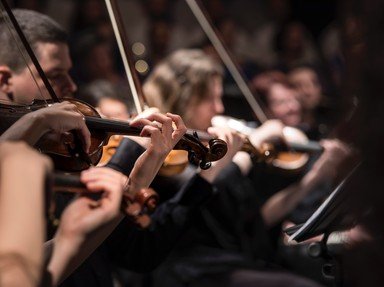Quiz Answer Key and Fun Facts
1. In 1555, Pope Marcellus decreed that church music "must be sung in a fitting manner, with properly modulated voices, so that everything may be heard and understood". Which Italian composer undertook to compose a mass in honor of Pope Marcellus which adhered to these principles?
2. This German composer lived from 1585-1672; his output includes a setting of the Passion, a Christmas oratorio, a setting of the entire book of psalms, several madrigals, instrumental music, and a large body of sacred pieces.
3. This Italian composer's works bridge the Renaissance and Baroque eras. His best known choral works are his madrigals (both spiritual and secular) and his "Vespro della Beata Vergine". He is principally known, however, for being the first truly great operatic composer.
4. The choral works of Johann Sebastian Bach include the great Mass in B Minor, the Magnificat in D, over one hundred church cantatas, and two mighty settings of the Passion from the gospels of these two evangelists.
5. Best known for his oratorio "Messiah", Georg Frederick Handel also wrote this great oratorio which includes choruses about swarms of insects, fire and hail, and darkness and an aria about frogs and diseased cattle.
6. The famous "Hallelujah Chorus" is sung at the conclusion of Handel's "Messiah".
7. Haydn's great oratorio "The Creation" opens with an orchestral prelude. What does it describe?
8. Which of the following is NOT a setting of the mass by Mozart?
9. Which three sections of Mozart's great Requiem were entirely composed by his pupil Sussmayer after his death?
10. This great choral work of Beethoven was written with the inscription "From the heart, may it go to the heart."
11. Which great German poet wrote the text used for Beethoven's great Ninth symphony (the "Ode to Joy")?
12. This French composer's Requiem includes four brass choruses, a movement in which the chorus sings only two notes in repetition, and another movement in which the orchestral accompaniment consists of flutes and trombones.
13. Which of the following is true of Johannes Brahms' great "Deutsches Requiem"?
14. These two Italian opera composers each wrote a major sacred choral work in operatic style. One, known primarily for his operatic comedies, wrote a setting of the Stabat Mater. The other wrote a powerful setting of the Requiem in honor of a great Italian author. Ironically, the latter composer's Requiem had started out as a joint work with other prominent Italian composers of his day on the occasion of the previous composer's death.
15. The music of this Austrian composer includes several settings of the mass, a Te Deum, and several motets.
16. Apart from Beethoven, which of these great symphonists wrote symphonies utilizing chorus and soloists?
17. Carl Orff's great "Carmina Burana" is based on medieval German-Latin poetry and is divided into seven sections. What is the theme of the beginning and closing section of the work?
18. "Belshazzar's Feast" is a "partita for chorus and orchestra" by this British composer best known for composing the scores for Laurence Olivier's Shakespearean films, and for the royal march "Crown Imperial".
19. This twentieth century British composer's choral works include "Rejoice in the Lamb", "A Ceremony of Carols", "Five Flower Songs", "A War Requiem", and "A Festival Te Deum."
20. "In the Beginning" is an exciting choral work by this American composer, also known for "Rodeo", "Billy the Kid", and "Appalachian Spring".
21. In what language did Leonard Bernstein write his "Chichester Psalms"?
22. This French composer's works include a setting of the "Gloria", four Lenten motets, four Christmas motets, a Litany to the "black virgin", and a Stabat Mater.
23. This Russian composer, best known for his piano works, composed a setting of the Russian vespers and a choral setting of Edgar Allen Poe's poem "The Bells".
24. The Requiem settings of French composers Gabriel Faure and Maurice Durufle omit this section of the mass.
25. Which of these great twentieth century composers wrote the "Symphony of Psalms"?
Source: Author
jouen58
This quiz was reviewed by FunTrivia editor
bullymom before going online.
Any errors found in FunTrivia content are routinely corrected through our feedback system.


